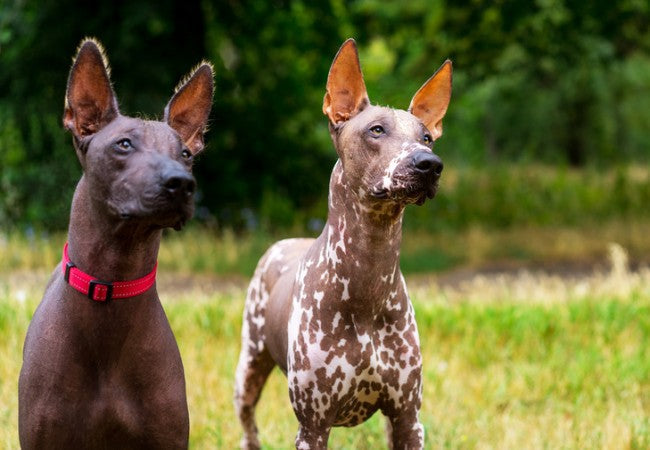Vet Guide 2025 Hairless Dog Breeds Care & Skin Protection 🐶🩺

In this article
Vet Guide 2025 Hairless Dog Breeds Care & Skin Protection 🐶🩺
By Dr. Duncan Houston BVSc
Hairless dog breeds—like the Xoloitzcuintli, Chinese Crested, American Hairless Terrier, and Peruvian Inca Orchid—have unique charm and benefits, especially for allergy-prone families. But their exposed skin means they need extra protection and TLC. As a veterinarian, I’ve designed this definitive guide to help you understand breed traits, health considerations, and daily care with expert support from Ask A Vet. Let’s ensure your naked pup thrives! 🐶✨
1. Popular Hairless Breeds & Origins 🌍
- Xoloitzcuintli (Mexican Hairless): Ancient Aztec lineage; comes in toy, miniature, and standard sizes. Loyal, alert, and calm—great watchdogs.
- American Hairless Terrier: Born from rat terriers in the 1970s USA. Energetic, smart, and friendly—AKC recognized.
- Chinese Crested: Hairless (with tufts) and powderpuff varieties; affectionate, intelligent toy breed.
- Peruvian Inca Orchid: National dog of Peru; comes in three sizes, elegant, athletic, and protective.
- Argentine Pila, Hairless Khala, Jonangi & others: Rare South American/Indian breeds; similar needs—skin care, warmth, sun protection.
2. Health & Genetic Concerns 🩺
Despite lacking fur, hairless breeds face breed-specific health issues:
- Xolo: May suffer from hip dysplasia and patellar luxation.
- American Hairless Terrier: Watch for patella luxation, heart murmur, primary lens luxation, and potential seizures.
- Chinese Crested: Skin issues, dental abnormalities, eye diseases (lens luxation, PRA), heartbeat defects.
- All Hairless Breeds: May have fewer teeth, acne, sensitive skin, missing sweat glands from the FOXI3 mutation.
3. Care Essentials: Skin, Sun & Warmth ☀️🧣
- Sun Protection: Use pet-safe sunscreen or sun shirts to prevent burns and long-term skin cancers—studies show squamous cell risk.
- Warmth: Provide sweaters, jackets in cold weather—no fur means poor insulation.
- Eye & Dental Care: Brush teeth daily; monitor for eye issues—consult Ask A Vet regularly.
4. Grooming & Hygiene Routine 🧼
- Trim nails, ears, and check paw pads frequently.
- Clean eyes and ears gently to prevent infection.
- Maintain hygiene of tufts (Chinese Crested) by brushing and trimming.
5. Nutrition, Supplements & Exercise 🍖
- Balanced diet with AAFCO-formulated kibble for skin and joint health.
- Provide regular exercise—daily walks and puzzle play from Woopf to maintain health and mental stimulation.
6. Environment & Comfort 🏠
- Maintain ambient indoor temperature; avoid drafts and overexposure to sun.
7. Vet Care & Monitoring 📆
- Schedule semi-annual checkups focusing on skin, joints, eyes, and dental health.
- Use Ask A Vet for photo-based remote check-ins if issues arise.
- Discuss regular screening for known breed issues like hip, joint, and lens luxation.
8. Behavior & Temperament Traits 🐾
Hairless breeds tend to be affectionate, intelligent, and occasionally stubborn. Early socialization and training help:
- Xolo: Watchful yet calm indoors—early training is key.
- American Hairless Terrier: Energetic—benefits from agility or puzzle training to prevent boredom.
- Chinese Crested: Sensitive—requires positive reinforcement and confidence-building exercises.
- Other Breeds: Adaptable but often bond deeply—awareness of separation anxiety is important.
9. Quick Breed Comparison Table
| Breed | Size | Lifespan | Key Care Needs |
|---|---|---|---|
| Xoloitzcuintli | 10–55 lb | 14–17 yr | Skin protection, joint checks |
| American Hairless Terrier | 12–28 lb | 14–16 yr | Skin care, warmth, dental health |
| Chinese Crested | 8–12 lb | 13–18 yr | Skin moisturize, eye/dental exams |
| Peruvian Inca Orchid | 9–55 lb | 10–12 yr | Sun & cold protection, athletic needs |
10. FAQs
- Are hairless dogs hypoallergenic?
- They shed less but still produce dander—may help allergy sufferers but not guarantee hypoallergenic status.
- Do hairless dogs need sunscreen?
- Yes! Use vet-approved sunscreen or UV-protective clothing to avoid burns and skin cancers.
- How often should hairless dogs?
- Weekly to biweekly—frequent baths help prevent skin issues from oils, debris, and sun exposure.
- Do hairless breeds get cold easily?
- Absolutely—provide sweaters, jackets, and indoor warmth during cooler months.
- Are they high maintenance?
- Skincare and sun protection require daily effort, but no fur brushing – overall moderate maintenance.
Conclusion
Hairless dogs are captivating companions with special needs. With tailored care—skin protection, moisturizing baths, warmth, and attentive monitoring—you can ensure they thrive. Combine professional support from Ask A Vet, and love to give your hairless friend a vibrant, happy life. 🐶💗






